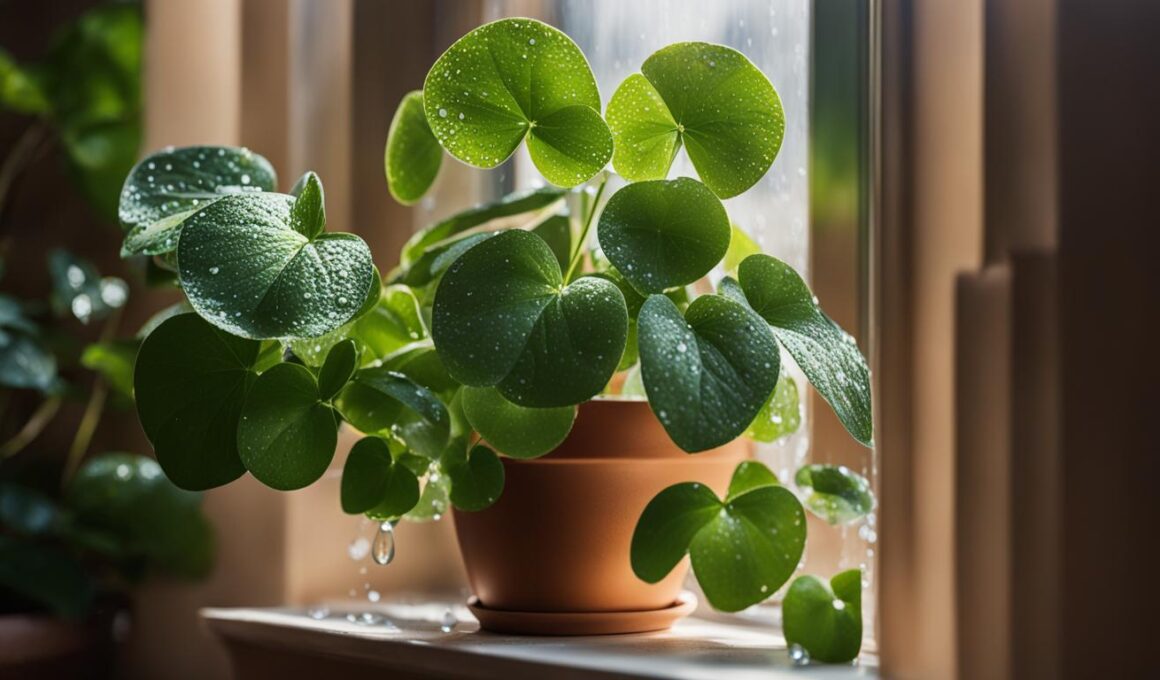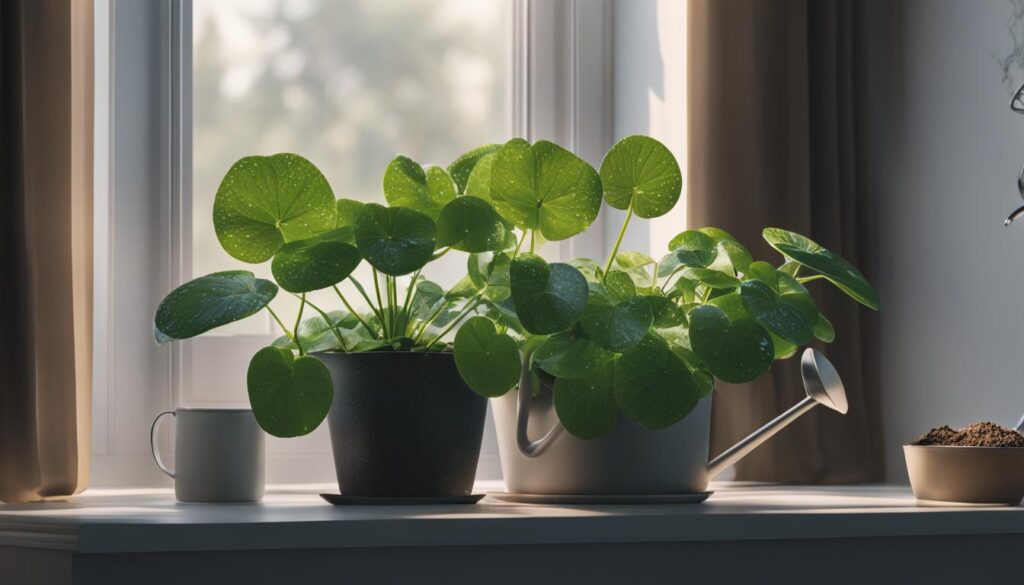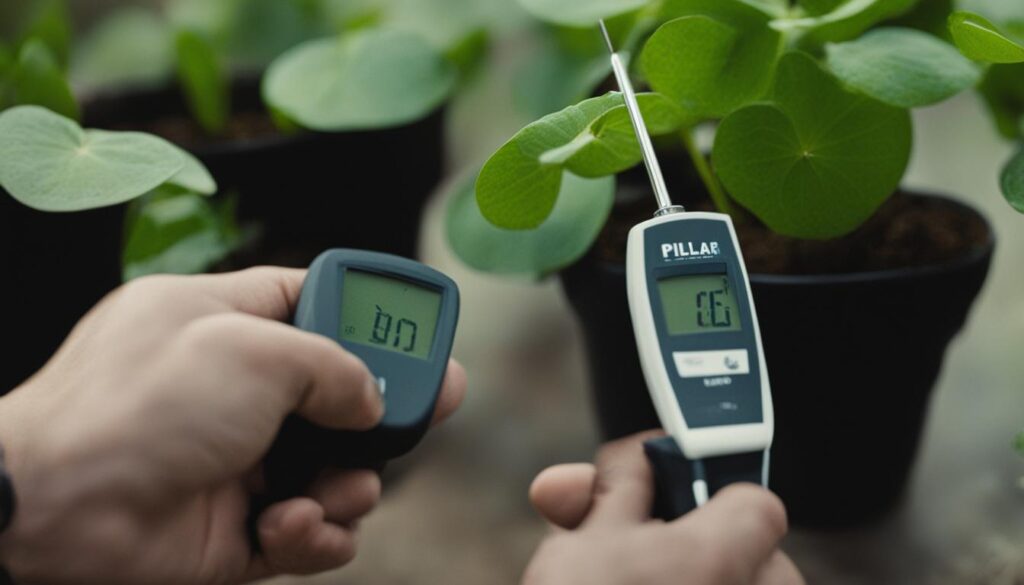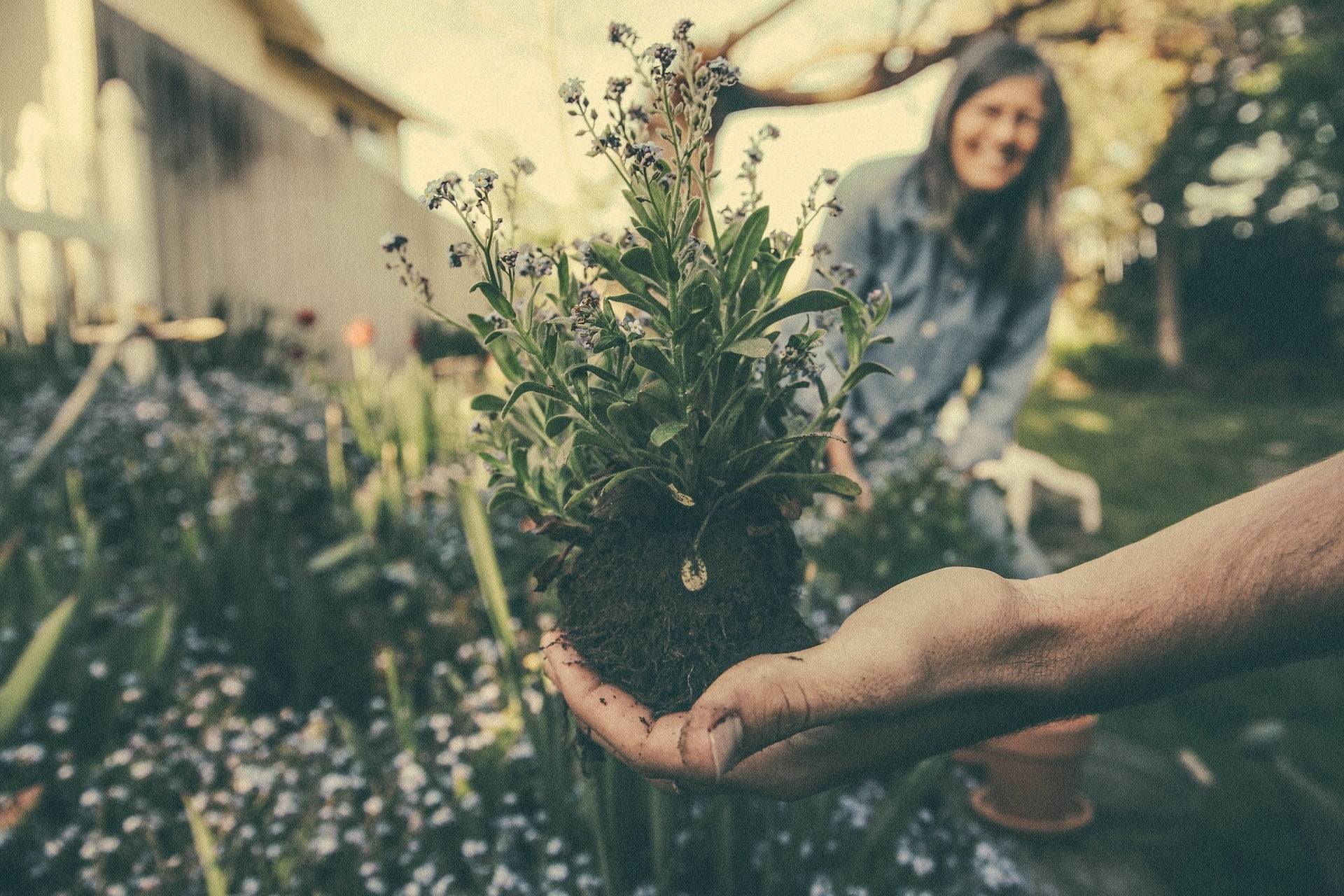Mastering the essential aspects of Pilea Plant Care requires a thorough understanding of proper watering techniques. When it comes to fostering optimal plant growth, striking the right balance between over- and under-watering is crucial. Overwatering can lead to root drowning, mold growth, and increased vulnerability to pests, while under-watering may result in stunted growth and shriveled leaves. Ensure the luxurious growth of your Pilea by implementing the most effective watering practices for the best root health, mold prevention, and overall thriving houseplants. All of this begins with accurately assessing your Pilea’s moisture needs.
Key Takeaways
- Prevent overwatering and root drowning by maintaining an ideal moisture balance.
- Ensure vibrant growth by understanding the unique watering requirements of your Pilea Plant.
- Utilize practical watering techniques to foster a healthier Pilea Plant habitat.
- Provide proper drainage, water quality, and lighting to create a thriving environment.
- Adjust your watering practices in response to seasonal changes and varying environmental conditions.
Understanding Pilea Plant Water Needs
The water needs of a Pilea plant can vary based on the season and the environment it is placed in. During summer, more frequent watering may be necessary, while in colder months, the watering should be scaled back, maintaining constant moisture. It’s a common misunderstanding that all plants require abundant water. Instead, Pilea owners should use the “2-inches test” to determine if the top inch of soil is dry before watering. Tools like a soil moisture gauge can also assist in preventing overwatering.
To better understand your Pilea’s specific water needs, it’s helpful to be aware of various factors that may influence its watering requirements. These factors include the following:
- Plant size and growth stage
- Pot size and material
- Indoor humidity levels
- Soil type
When considering these factors, the primary goal is to maintain a balance between overwatering and underwatering, which can both lead to poor plant health.
Seasonal Watering
During the warmer months, the Pilea plant requires more frequent watering to support its growth and keep it hydrated. Pay attention to the moisture levels in your plant’s soil and adjust your watering schedule as necessary. In the colder months, it can be beneficial to reduce the watering frequency, while ensuring constant soil moisture. Don’t forget to consider indoor humidity levels, as dry winter air might require slight adjustments in watering frequency.
| Season | Watering Frequency | Other Adjustments |
|---|---|---|
| Spring | Moderate | Gradually increase in response to warming temperatures |
| Summer | Frequent | Maintain soil moisture as the plant grows and transpires more |
| Fall | Moderate | Gradually decrease due to shorter days and cooler temperatures |
| Winter | Less frequent | Monitor indoor humidity and adjust accordingly |
Proper moisture assessment is crucial for the health of your Pilea plant, ensuring you’re providing the correct amount of water for its needs. By adapting your watering schedule to suit both the indoor environment and seasonal changes, you can promote healthy plant growth and keep your Pilea happy and hydrated.
The Art of Watering Pilea Plants: Techniques for Thriving Greenery
Mastering watering techniques is imperative for nurturing your Pilea plants to achieve luxuriant growth. This section sheds light on some of the essential aspects of Pilea watering, including bottom watering methods, choosing the right water type, and understanding the importance of drainage in Pilea plant care.
Bottom Watering: Saucer & Soak Methods
Employing the Bottom Watering Method is an excellent way to ensure thorough water intake for your Pilea plants, while preventing the risk of overwatering. There are two primary techniques in this method:
- Saucer Technique: Place your Pilea in a saucer filled with water for approximately 30 minutes, allowing its roots to absorb the moisture. Remove the plant from the saucer and let it drain to avoid excess water.
- Soak Method: Submerge the entire pot containing your Pilea in water until it ceases to emit bubbles. This indicates that the potting soil is fully saturated, ensuring sufficient Pilea Water Intake.
It is crucial to have pots with Drainage Holes when using either of the bottom watering techniques to facilitate efficient moisture absorption directly to the roots, mitigating the risks associated with topsoil watering, such as pests and fungal growth.
Choosing the Right Water Type for Your Pilea
Water Quality for Pilea is a vital aspect to consider since the presence of substances such as chlorine and fluoride in tap water can have negative effects on your plants. To counter Chlorine and Fluoride Effects, let the tap water sit open for one day before using it, allowing these harmful chemicals to dissipate. Alternatively, you can use Rainwater or melted snow to hydrate your plants. The use of Lukewarm Water for Plants, rather than hot or cold water, is also recommended to avoid shocking the plant’s system.
Importance of Drainage in Pilea Plant Care
Implementing an efficient Pilea Drainage System is a crucial aspect of maintaining your Pilea plant’s health. Effective drainage helps in Root Rot Prevention by eliminating stagnant water that can cause the onset of mold and fungus, ultimately avoiding the Overwatering Risks.
To safeguard your Pilea plants from overwatering, place a Drainage Pan under the pot to collect excess water. Make sure to empty the pan within 30 minutes of watering, thereby ensuring that your Pilea is not sitting in excess moisture that can be detrimental to its overall well-being.
Assessing Moisture Levels: When to Water Your Pilea
Knowing when to water your Pilea plants is crucial to their health and vitality. Paying close attention to soil moisture levels can help avoid overwatering and under-watering, ensuring healthy plant growth. In this section, we will discuss the Soil Moisture Test, overwatering indicators, Pilea watering schedule, and signs of dry soil. Armed with this knowledge, you will be able to create an effective watering plan for your Pilea plants.
- Soil Moisture Test: To determine the proper watering time for a Pilea, conduct the “2-inches test” by checking the soil’s dryness an inch from the top. If the soil is dry at that depth, it is time to water your plant.
- Overwatering Indicators: Be on the lookout for signs of overwatering such as yellowing leaves, root rot, and a musty smell. If you notice these issues, it’s time to adjust your Pilea watering schedule.
- Pilea Watering Schedule: Establishing a consistent watering schedule for your Pilea is essential. This schedule should take into account their moisture needs and the specific humidity of your home environment.
- Dry Soil Signs: Watch for signs that your plant’s soil is too dry, such as wilting leaves, leaf drop, and browning leaf edges. If you see these symptoms, it is time to water your Pilea plant.
How to Use a Soil Moisture Gauge
A soil moisture gauge can be an invaluable tool for measuring the moisture level in your Pilea plant’s soil, especially for those who tend to overwater. To use a soil moisture gauge, simply insert it into the soil near your plant’s roots and observe the reading. A reading of “dry” or “moist” may indicate that it is time to water, depending on your specific Pilea variety. Consult the provided table for an ideal moisture range for your Pilea plant.
| Pilea Variety | Ideal Soil Moisture Level |
|---|---|
| Pilea peperomioides (Chinese Money Plant) | Moderately Moist |
| Pilea depressa (Baby Tears) | Consistently Moist |
| Pilea cadierei (Aluminum Plant) | Moderately Moist |
| Pilea involucrata (Friendship Plant) | Moderately Moist to Slightly Dry |
By assessing moisture levels and understanding the nuances of your Pilea’s watering needs, you can ensure that your plant receives the optimal amount of water. Remember to remain vigilant for overwatering indicators and dry soil signs, adjusting your Pilea watering schedule as needed. With proper care and attention, your Pilea will thrive in your home environment.
Pilea’s Environmental Preferences: Seasons and Watering Adjustments
As you nurture your Pilea to maintain its lush beauty, pay close attention to Seasonal Pilea Care and Environmental Watering Considerations. Understanding the importance of adjusting your Plant Watering Routine based on seasonal changes and environmental factors will enable you to develop an Adaptive Watering strategy for your Pilea plants.
A core component of adaptive watering is to increase or decrease the plant’s water intake to adapt to seasonal variations. During the summer months, Pilea plants may require more frequent watering due to higher temperatures and increased evaporation. Conversely, in the winter months, water intake can be reduced while still maintaining a constant moist environment for your plant.
- Seasonal Temperature Changes: As temperatures rise in warmer months, the plant’s water needs increase. Ensure you water the plant accordingly to maintain optimum moisture levels.
- Local Humidity: Higher humidity levels in your environment can impact the plant’s water requirements. In highly humid areas, reduce watering frequency to prevent overwatering, while in drier climates, increase watering to maintain consistent moisture.
- Indoor vs. Outdoor: Pilea plants are usually grown indoors, but if you choose to keep your plant outdoors during warmer months, it’s vital to monitor your plant’s water needs closely, as they can be quite different from indoor requirements.
Beyond adapting to seasonal changes, other environmental factors also warrant consideration when establishing a watering schedule for your Pilea:
- The amount of direct sunlight and the plant’s location can affect soil drying speed; use this information to calibrate your watering frequency.
- Plants placed near air vents or radiators may need more water due to the drying effect of heating and cooling systems.
- As Pilea plants mature, their root systems will expand, potentially requiring an adjustment in watering frequency to accommodate the growing plant.
By mastering an adaptive watering approach for your Pilea plants, which encompasses seasonal requirements and environmental considerations, you can ensure they stay healthy and maintain a thriving, lush appearance throughout the year.
Watering, Light, and Location: Tips for Perfect Pilea Placement
Finding the right balance of light and environmental factors is essential for your Pilea plant to thrive. An optimal location ensures proper exposure to sunlight and encourages healthy growth.
Pairing Pilea with Proper Sunlight
Understanding Pilea Light Requirements is vital for optimal plant health. Ideally, the Pilea plant should be exposed to bright, Indirect Sunlight. Prolonged Direct Sun Exposure may lead to Leaf Discoloration and burns on the leaves. When planning Window Placement, consider areas that provide enough light without direct sunbeams. To ensure balanced growth and prevent the plant from leaning towards the light source, rotate your Pilea plant regularly.
Choosing the Best Spot for Your Pilea Plant
Indoor Plant Placement and Environmental Adaptation are essential in selecting the perfect location for your Pilea. Consider the following factors when choosing the best spot:
- Temperature: Pilea plants can suffer if exposed to temperatures below 50°F (10°C). Ensure that your Pilea is placed in a warm space, away from drafts and cold windows.
- Humidity: Experiment with Humidity Considerations for optimal Pilea growth. Maintain a consistent approach to humidity management, such as daily misting, pebble trays, or using a humidifier, to keep the plant vibrant and healthy.
- Environment: Avoid placing the Pilea in dry environments that might cause leaf crisping and drooping due to under-watering. Select a spot that provides consistent moisture levels for the plant.
By taking into account your Pilea’s light requirements, temperature needs, and humidity preferences, you can choose the Optimal Pilea Location to ensure your plant’s health and well-being.
Can Rockwool Alternatives Provide Proper Watering for Pilea Plant Growth?
Many rockwool alternatives offer sustainable hydroponic substrates that can provide proper watering for Pilea plant growth. These substrates are designed to retain moisture while allowing for optimal root aeration, creating an ideal environment for healthy and thriving plants.
Optimizing Pilea Plant Care for a Thriving Indoor Garden
Mastering the art of Pilea Plant Upkeep lies in understanding the nuanced demands of these lush, tropical plants. From developing Successful Watering Practices to addressing environmental factors and promoting Healthy Plant Growth, even novice gardeners can bring forth vibrant greenery within their living spaces. By remaining attuned to the necessary adjustments in care and responding accordingly, your Pilea plants can truly flourish and become an integral part of your Indoor Gardening endeavors.
Staying observant of your Pilea plant’s moisture requirements and reacting to seasonal changes will position you for success in your journey as an indoor gardener. Employing the “2-inches test” to ensure proper moisture levels, maintaining consistent humidity, and providing the right amount of light will lead to thriving, healthy plants. Whether you’re a seasoned horticulturist or budding enthusiast, perfecting Pilea plant care techniques can contribute to an enchanting, verdant indoor space.
A commitment to understanding the intricate needs of Pilea plants will set the stage for exceptional care and lush growth. Using bottom watering techniques like the saucer and soak methods, ensuring adequate drainage, and offering high-quality water free of harmful chemicals will contribute to a flourishing Pilea oasis. Remember, each of these aspects play a role in creating a nourishing environment for your plants, so maintaining an informed, holistic approach to their care is essential.
In conclusion, providing optimal care for your Pilea plants will ensure they grow luxuriantly, adding splendor to your indoor garden. By honing your skills in watering practices, adapting to seasonal changes, and ensuring that environmental factors are conducive to growth, your Pilea plants will serve as a testament to your dedication and proficiency in indoor gardening. Keep nurturing your Pilea plants with mindfulness and expertise, and witness the lush rewards.











